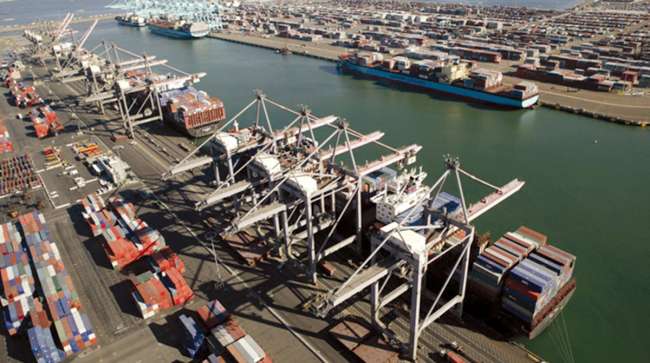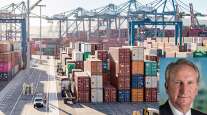Senior Reporter
Ports on Both Coasts See Drop-Off in Volume in November

[Stay on top of transportation news: Get TTNews in your inbox.]
Port container volumes on the West Coast and East Coast declined in November, although shippers were focused on different factors.
Labor talks between the 22,000-member International Longshore and Warehouse Union and Pacific Maritime Association, which represents 29 port and storage locations, continued to weigh on volumes. On the East Coast, cargo levels were driven by concerns over the economy.
However, in the past six months, East Coast ports have seen a significant uptick in container handling, even with the slightly lower November number.
The San Pedro Bay ports, in Los Angeles and Long Beach, Calif., saw a combined 23% year-over-year decline in container volume in November.
Cargo volume remained soft at the Port of Los Angeles in November as the Port handled 639,344 TEUs, a 21% decrease from November 2021. Overall, the #PortofLA has handled 7% less cargo in the first 11 months of 2022 compared to last year’s all-time record. https://t.co/EQNggKdDK9 pic.twitter.com/z8bZSD3n7C — Port of Los Angeles (@PortofLA) December 15, 2022
Los Angeles fell 21.2% to 639,343 20-foot-equivalent units compared with 811,459 in the same month a year ago.
Long Beach dropped 24.8% to 588,742 TEUs compared with 783,523 in 2021.
“Imports into the United States have begun to level off, in addition to cargo that has shifted away from West Coast ports due to protracted labor negotiations,” Port of Los Angeles Executive Director Gene Seroka said. “In the months ahead, we’re going to have to work harder and smarter to earn cargo back. Every ship, every train, every truck needs to be handled with the top-level service our customers expect and deserve.”
Overall, Los Angeles has handled 7% less cargo in the first 11 months of 2022 compared with last year’s all-time record. Long Beach is down 0.5% when measured against 2021.
Trade moving through #POLB eased in November amid reduced orders from retailers, full warehouses, vessel transfers between the San Pedro Bay ports and goods shifted toward seaports along the East and Gulf coasts.
Find the full cargo release here: https://t.co/kzjeYUNyHd pic.twitter.com/kBOYCNA12U — Port of Long Beach (@portoflongbeach) December 14, 2022
“While some import volume has shifted to other gateways, we are confident that a good portion of it will return to the San Pedro Bay,” Port of Long Beach Executive Director Mario Cordero said.
White House Supply Chain Envoy Stephen Lyons told Transport Topics there is more going on with the shift from West to East than just concern over the labor talks.
“The trade routes are shifting as well as manufacturing migrates from mainland China to other locations, South and Southeast Asia, also locations like Mexico and some onshoring that impacts important trade routes. You can make the East Coast and Gulf Coast more attractive for shippers,” Lyons said.

"I am confident West Coast freight volumes will recover," Lyons says. (Dan Ronan/Transport Topics)
“And yes, shippers and carriers have been monitoring the ILWU negotiations, no doubt about that. Even though container imports are down, consumer demand still remains healthy,” he added. “I’m confident that West Coast freight volumes will recover. The fact is that the West Coast ports will always have positional advantage on transpacific routes. So I think we’ll see a recovery. I think this is temporary. I don’t know that all the cargo will go back, but I think some of it will indeed.”
The Ports of Oakland, the Northwest Seaport Alliance and the Port of New York and New Jersey did not have November cargo volumes at press time.
In the Gulf Coast, Port Houston saw a 10.9% year-over-year increase in November, processing 348,950 TEUs compared with 314,576.
What a year it’s been for @Port_Houston. We’re continuing to see record highs across our terminals and hardly any slow down in cargo movement. Special thanks to all of the stakeholders and partners we work with every day to keep cargo reaching its destination. pic.twitter.com/hK5JqWtPf8 — Port Houston (@Port_Houston) December 15, 2022
“It takes time to reroute shipping, and what we’re seeing the results of now is other decisions that were made by shippers many, many months ago to reroute to the East, to the Gulf Coast to avoid congestion,” Lyons said.
Houston’s container volume is up 17% year-to-date through November, totaling 3,682,874 TEUs. The week before Thanksgiving marked the highest ever for truck transactions, with more than 70,000.
“The long term for container growth in Houston is extremely favorable. Retailers continue to invest in distribution centers in our region that are served through our port,” Port Houston Executive Director Roger Guenther said.
The long term for container growth in Houston is extremely favorable.
Port Houston Executive Director Roger Guenther
Image
Container volumes on the East Coast also declined at the major ports in November.
The Port of Savannah reported a 6.2% decline, processing 464,883 TEUs compared with 495,749 in 2021.
Even with the dip, the Georgia facility still is on track to shatter 2021’s record of 5,613,163 when the final December numbers are released in mid-January.
Compared with November 2019, the Port of Savannah’s performance constitutes a 28% increase over three years.

Lynch
“Container trade at U.S. ports is returning to a more sustainable growth pattern, which is a positive development for the logistics industry” Georgia Port Authority Executive Director Griff Lynch said. “Along with the addition of more than 1 million TEUs of annual capacity, a slight reduction in demand will mean faster vessel service as we work to bring a new big-ship berth online at Garden City Terminal in July.”
The South Carolina Port Authority, which operates the Port of Charleston, processed 15% fewer containers in November compared with 2021, moving 213,073 versus 250,711.
Like Savannah, the South Carolina facility is on track to easily pass its 2021 record volume with even a mediocre December.
The Port of Virginia reported a 1.7% decline, moving 285,825 TEUs compared with 290,759 a year ago.
“Economic conditions have softened a bit, but overall we’re in excellent shape,” Port of Virginia spokesman Joe Harris told TT. “We’ve had an excellent year.”
Want more news? Listen to today's daily briefing below or go here for more info:





